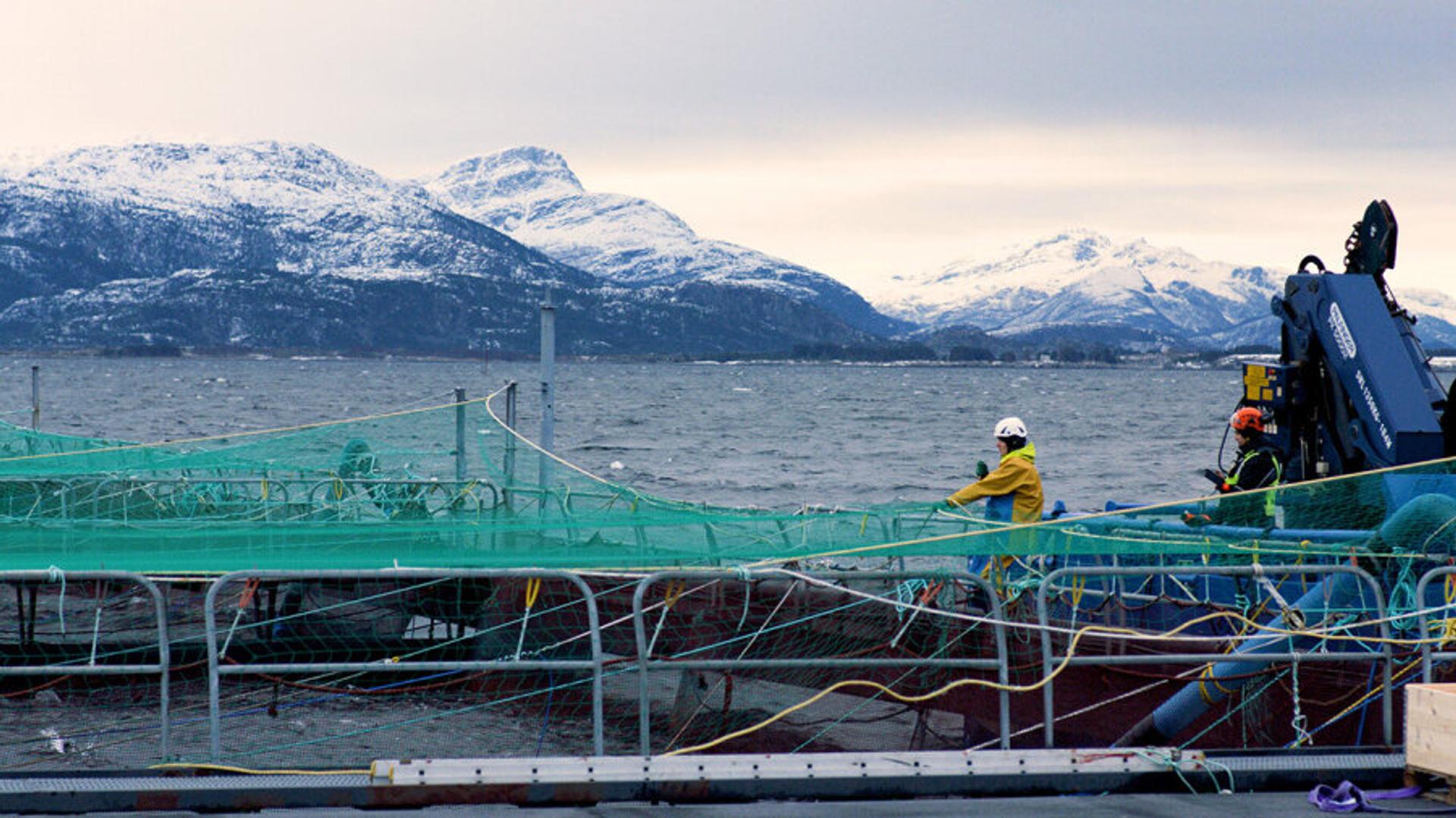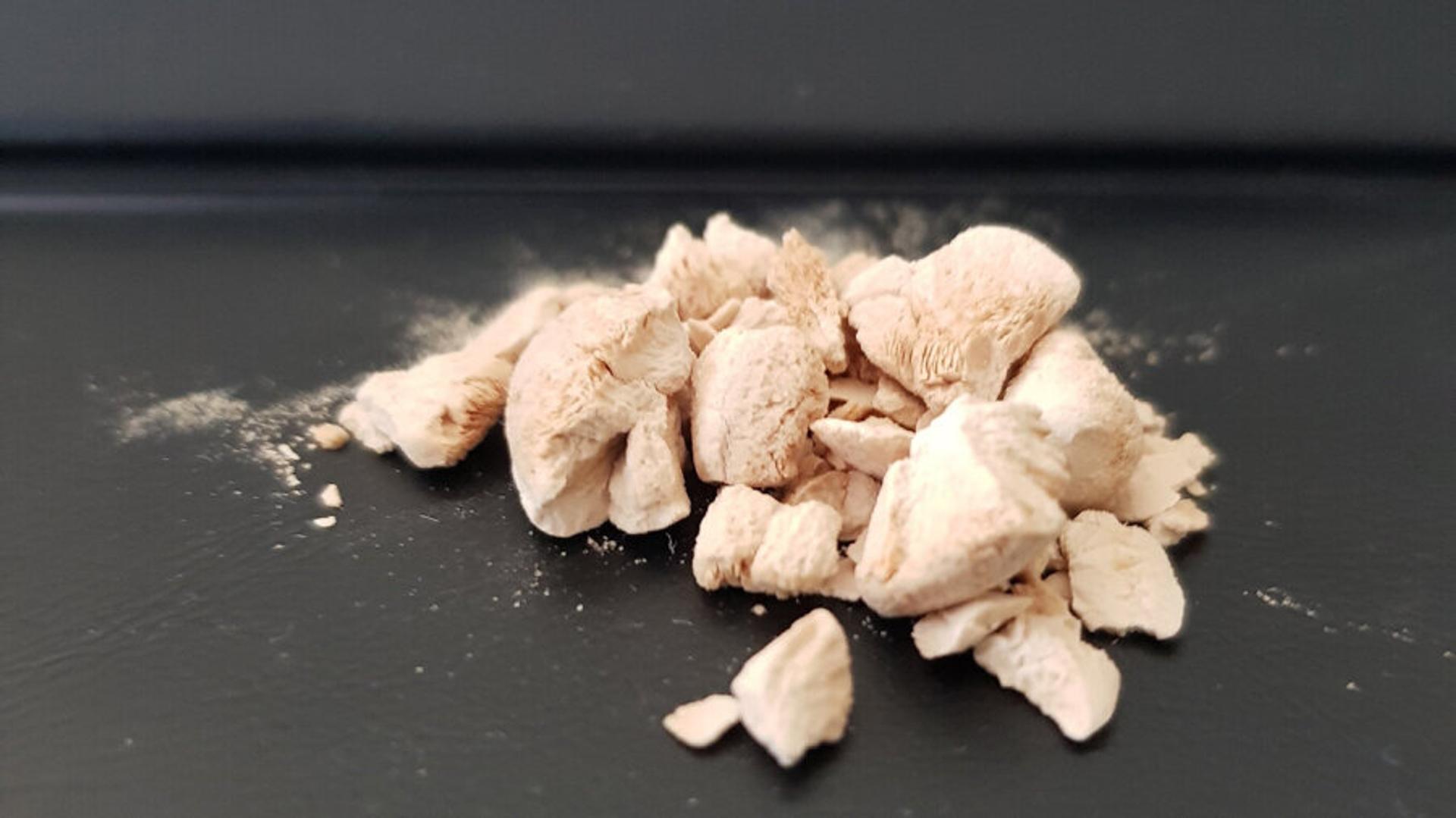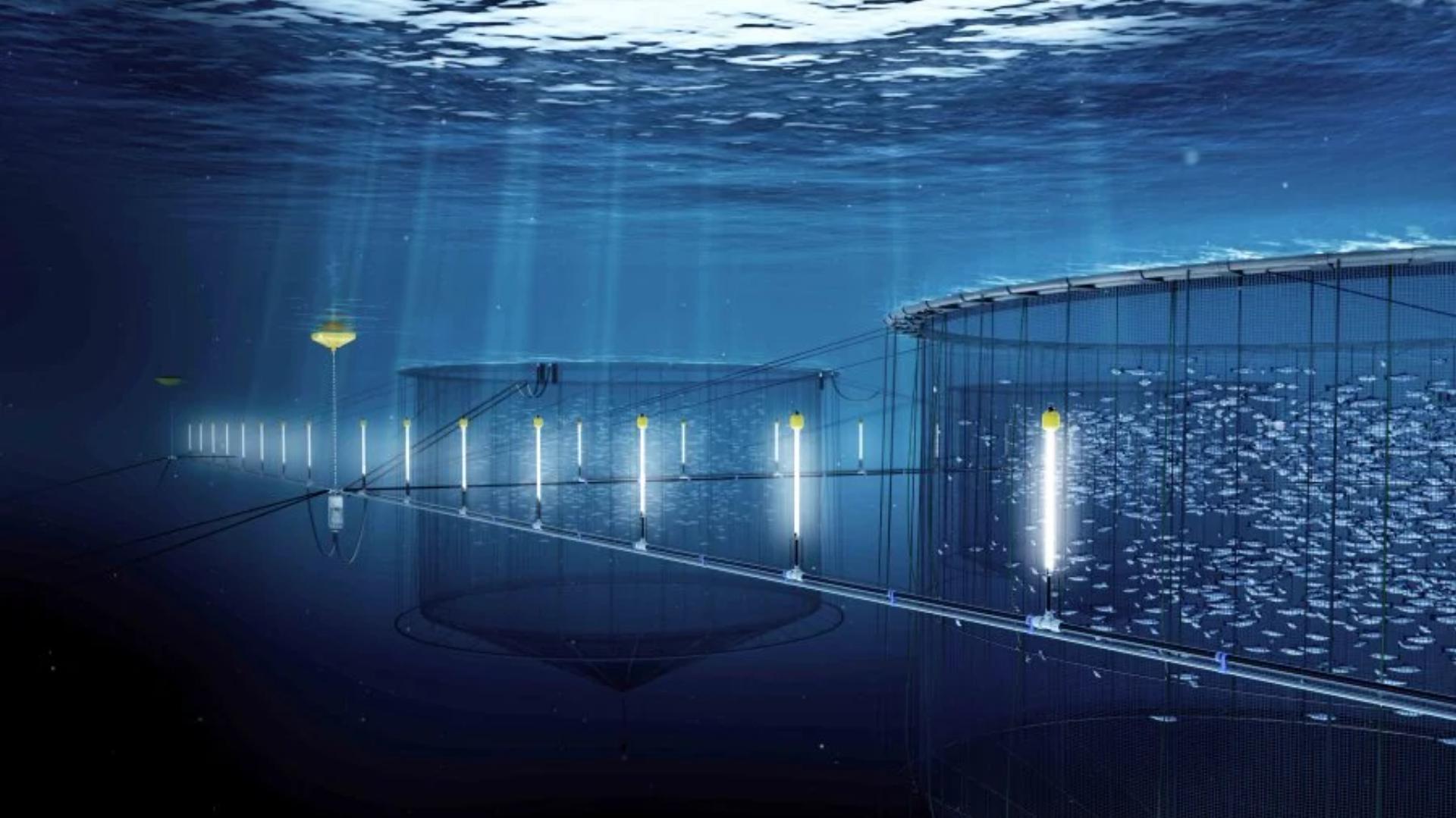Norwegian technology for sustainable aquaculture

The global population is growing rapidly. Today there are over 8 billion people on earth, and the UN forecasts that the population can reach nearly 9.7 billion as early as 2050. Sustainable, large-scale production of nutritious food will be required to make sure that everyone is adequately fed.
Fish and other seafood are some of the most important sources of animal protein, fats and Omega-3 fatty acids – all of which are vital nutrients. Moreover, aquaculture also has a significantly smaller carbon footprint than many types of meat production.
There are, however, a number of problems associated with intensive, large-scale production of fish in the sea. Faeces and spilled feed, which may contain nitrogen and phosphorus, can pollute the water column and local environment. Moreover, controlling sea lice without damaging fish or the surrounding ecosystem has been a longstanding challenge.
Meanwhile, as the industry has grown, procuring enough nutritious fish feed has become an issue. Production of essential marine ingredients such as fish meal and fish oil has decreased by half during the past decade.
Emerging technology is helping to solve these problems, and Norway is leading the way. With its extended, biologically diverse coastline and centuries-long fishing traditions, Norway has tremendous expertise in aquaculture and fisheries which the country is applying in technology development.
 InControl software gives fish farmers digital superpowersInControl Aquaculture is a web-based quality control system for fish farms, increasing sustainability and profitability in the industry. “We could not produce the world’s best salmon without InControl,” says Nils Tore Karstensen, Chairman of E. Karstensen Fish Farming.
InControl software gives fish farmers digital superpowersInControl Aquaculture is a web-based quality control system for fish farms, increasing sustainability and profitability in the industry. “We could not produce the world’s best salmon without InControl,” says Nils Tore Karstensen, Chairman of E. Karstensen Fish Farming. Spillfree fights feed waste in aquacultureThe world now produces more seafood from fish farms than wild catch. Spillfree software tools optimise fish growth and control costs, with a focus on feeding. “When you are involved in aquaculture, the greatest key to success with any species is in managing your feeding. That is a key rule,” says Vidar Myhre, CEO of Spillfree.
Spillfree fights feed waste in aquacultureThe world now produces more seafood from fish farms than wild catch. Spillfree software tools optimise fish growth and control costs, with a focus on feeding. “When you are involved in aquaculture, the greatest key to success with any species is in managing your feeding. That is a key rule,” says Vidar Myhre, CEO of Spillfree. More meals to the table with autonomous fish feeding from CageEyeCageEye’s autonomous feeding solution combines hydroacoustics and machine learning to optimise feeding and promote efficient and sustainable aquaculture.
More meals to the table with autonomous fish feeding from CageEyeCageEye’s autonomous feeding solution combines hydroacoustics and machine learning to optimise feeding and promote efficient and sustainable aquaculture. Gas 2 Feed turns air into sustainable fish feedGas 2 Feed converts air, water and electricity into protein, creating a sustainable fish feed ingredient and reducing the carbon footprint of aquaculture. “Our technology replicates nature to make sustainable food using fermentation,” says Jarle Dragvik, CEO of Gas 2 Feed.
Gas 2 Feed turns air into sustainable fish feedGas 2 Feed converts air, water and electricity into protein, creating a sustainable fish feed ingredient and reducing the carbon footprint of aquaculture. “Our technology replicates nature to make sustainable food using fermentation,” says Jarle Dragvik, CEO of Gas 2 Feed.
Innovative and sustainable sea lice prevention
Sea lice are one of the most pressing challenges facing the aquaculture industry. These parasites release their eggs into the water. The eggs develop into larvae that attach themselves to fish, retarding their growth, disrupting their salt balance and making them vulnerable to disease and predation. Until now, drugs and chemicals have been the predominant method of controlling sea lice. Sea lice, however, have begun to acquire resistance to delousing agents.
Norwegian companies have been using their creativity to prevent this pest from attacking fish. Harbor has created the Harbor Fence, which uses electrical pulses to inactivate sea lice before they attach to the fish. This stops infestation within the cage and further spread to the surrounding environment – without any damage to the fish.
Stingray Marine Solutions, meanwhile, uses lasers to shoot down sea lice. The company’s advanced system uses AI technology to scan each individual fish for parasites and then destroys the lice one by one with a laser. Because the method does not involve handling or moving the fish, it can be used to remove and control sea lice on a continuous and preventive basis.
Another preventive method is to discover sea lice at an early stage. This calls for effective monitoring of fish and counting of sea lice. Fishency Innovation has developed a high-tech alternative to manual counting. The company’s SmartFunnel combines hardware with advanced machine learning and is installed underwater in the cages. As the fish swim through the funnel, a high-resolution, 360-degree image is taken by a camera. The system analyses the data and quickly identifies fish with traces of sea lice on their body. It can also be used to monitor other fish welfare parameters.
Blue Lice takes yet another approach by preventing sea lice from entering the cage in the first place. Its system acts like a mosquito trap, luring in sea lice through a combination of attractors and then containing them. The system takes advantage of the sea lice’s instincts, making the trap more attractive than the salmon.
 Harbor's electrical fence prevents sea lice in salmon farmsThe Harbor Fence uses electrical pulses to prevent sea lice from infecting salmon, providing a sustainable solution to a pressing problem in aquaculture.
Harbor's electrical fence prevents sea lice in salmon farmsThe Harbor Fence uses electrical pulses to prevent sea lice from infecting salmon, providing a sustainable solution to a pressing problem in aquaculture. Stingray controls parasites in fish farms with machine vision and laserStingray’s advanced solution removes and controls sea lice in fish farming pens around the clock, while minimising impact on the environment and fish.
Stingray controls parasites in fish farms with machine vision and laserStingray’s advanced solution removes and controls sea lice in fish farming pens around the clock, while minimising impact on the environment and fish. Fishency Innovation’s 360-degree imaging controls spread of sea liceFishency Innovation has developed the SmartFunnel for digital sea lice counting and monitoring to improve lice prevention and safeguard fish health and the environment.
Fishency Innovation’s 360-degree imaging controls spread of sea liceFishency Innovation has developed the SmartFunnel for digital sea lice counting and monitoring to improve lice prevention and safeguard fish health and the environment. Blue Lice protects salmon farms against sea liceBlue Lice switches focus from treatment to prevention of sea lice. Its system acts like a mosquito trap, attracting, capturing and containing sea lice before they reach the salmon.
Blue Lice protects salmon farms against sea liceBlue Lice switches focus from treatment to prevention of sea lice. Its system acts like a mosquito trap, attracting, capturing and containing sea lice before they reach the salmon.
Revolutionising fish feed
Worries about decreasing availability of marine ingredients for fish feed have long loomed over fish farmers. High-quality feed that meets the nutritional demands of fish, particularly in the larval stage, is essential for healthful, tasty fish. Rotifera, or wheel animals, and Artemia nauplii, or brine shrimp, are the most common live feed organisms used in aquaculture in Europe today.
Substantial amounts of soy are imported for use in dry fish feed, but this may be cultivated at the expense of local ecosystems. The aquaculture industry has to find new feed ingredients that maintain nutritional quality while sparing the environment.
C-Feed has developed an exciting, environment-friendly live starter feed, intensively farming copepods at its land-based facility in Norway. Copepods are zooplanktons found in abundance in all the world’s oceans, where they are the natural prey organisms for wild marine fish and prawn larvae. Nutrition-wise, copepods are superior to other types of starter feed. C-Feed’s facility is biosecure, eliminating the risk of contamination and pathogens, and the copepods are fed with CO₂-absorbing algae, ensuring carbon-positive production.
Zooca® – The Calanus® Company, meanwhile, produces superior feed ingredients from the zooplankton Calanus finmarchicus – the Norwegian Sea’s largest renewable and harvestable resource.
 C-Feed turns CO₂ into superior starter feed for aquacultureLow quality starter feed is limiting the growth of aquaculture. Using copepods, C-Feed has developed a live starter feed that gives higher yields and healthier fish with fewer resources.
C-Feed turns CO₂ into superior starter feed for aquacultureLow quality starter feed is limiting the growth of aquaculture. Using copepods, C-Feed has developed a live starter feed that gives higher yields and healthier fish with fewer resources. Zooca® produces superior aquaculture feed ingredients from renewable marine resourceZooca® – The Calanus® Company produces superior feed ingredients from the zooplankton Calanus finmarchicus – the Norwegian Sea’s largest renewable and harvestable resource. The ingredients are tailored for aquaculture species and have shown to have a positive impact on growth, health and survival.
Zooca® produces superior aquaculture feed ingredients from renewable marine resourceZooca® – The Calanus® Company produces superior feed ingredients from the zooplankton Calanus finmarchicus – the Norwegian Sea’s largest renewable and harvestable resource. The ingredients are tailored for aquaculture species and have shown to have a positive impact on growth, health and survival.
Sustainable offshore aquaculture
Today most marine aquaculture facilities are located in fjords or along the coastline. Waste feed, faeces, fish escapes and high concentrations of parasites have negative impacts on both the local environment and wild fish stocks.
Environmental Vision Norway (EVN) has developed the Autonomous Offshore Fish Farming Vessel. The vessel’s fish pens are equipped with uniquely constructed autonomous current deflectors that shield smaller fish from potentially deadly ocean currents, at the same time allowing bigger fish to swim deeper as they grow stronger. The vessel is designed for anchoring in unsheltered areas and is suitable for use in most locations around the world.
Sustainable closed-system aquaculture
Another way of solving the environmental challenges associated with marine aquaculture along the coastline is to enclose the fish farms. Closed facilities prevent fish escapes, eliminating risks to wild fish stocks, and allow waste to be collected instead of being released. They also significantly reduce the risk of sea lice outbreaks.
Bluegreen Technologies has created the Marine Donut, a submerged closed or semi-closed system for farming salmon. The facilities have a deep-water intake to ensure optimal water quality. The Marine Donut is particularly useful for the latter stages of fish production, in the period before slaughter, as the largest fish are most susceptible to sea lice.
FishGLOBE Technologies, meanwhile, has developed a globe-shaped, fully enclosed, mobile fish farming unit. Seawater is pumped into the tank from depths of 15 m or more – from below the “sea lice belt”. Thus, the FishGLOBE tank not only provides a cleaner, healthier environment for farmed salmon, but can also prevent sea lice from attaching to their skin.
 Marine Donut for closed-system salmon farming at seaMarine Donut is a new, escape-proof technology for closed or semi-closed fish farming at sea. Once fully developed, it will produce premium quality salmon with a minimal environmental footprint.
Marine Donut for closed-system salmon farming at seaMarine Donut is a new, escape-proof technology for closed or semi-closed fish farming at sea. Once fully developed, it will produce premium quality salmon with a minimal environmental footprint. FishGLOBE closed fish farms for more sustainable marine aquacultureFishGLOBE’s fully enclosed fish farming solution improves fish welfare, reduces emissions and nearly eliminates sea lice.
FishGLOBE closed fish farms for more sustainable marine aquacultureFishGLOBE’s fully enclosed fish farming solution improves fish welfare, reduces emissions and nearly eliminates sea lice. FiiZK’s closed waiting pens prevent disease spread in aquacultureAquaculture processing facilities can be hotspots for sea lice and other pathogens. FiiZK’s patented pens create a safe and protected environment for fish awaiting processing.
FiiZK’s closed waiting pens prevent disease spread in aquacultureAquaculture processing facilities can be hotspots for sea lice and other pathogens. FiiZK’s patented pens create a safe and protected environment for fish awaiting processing. FiiZK’s enclosed pens promote sustainable marine aquacultureFiiZK’s fully enclosed facilities for fish farming at sea provide superior conditions for fish, while reducing biomass loss and environmental impacts.
FiiZK’s enclosed pens promote sustainable marine aquacultureFiiZK’s fully enclosed facilities for fish farming at sea provide superior conditions for fish, while reducing biomass loss and environmental impacts.


